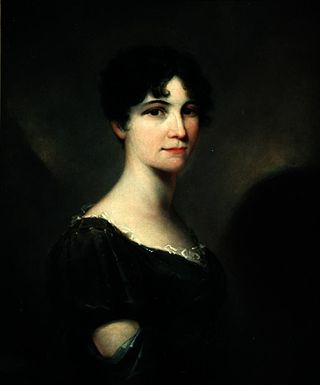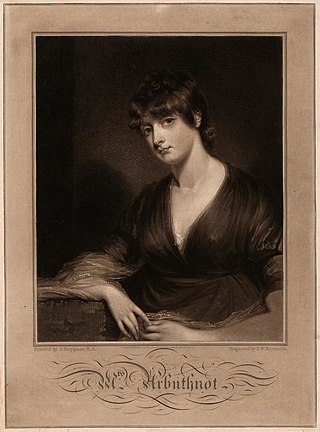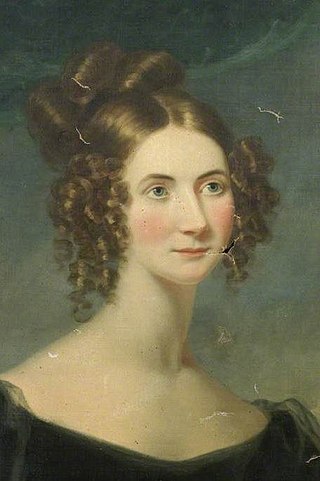
Caroline of Brandenburg-Ansbach was Queen of Great Britain and Ireland and Electress of Hanover from 11 June 1727 until her death in 1737 as the wife of King George II.

Dame Daphne du Maurier, Lady Browning, was an English novelist, biographer and playwright. Her parents were actor-manager Sir Gerald du Maurier and his wife, actress Muriel Beaumont. Her grandfather was George du Maurier, a writer and cartoonist.

Lady Caroline Lamb was an Anglo-Irish aristocrat and novelist, best known for Glenarvon, a Gothic novel. In 1812, she had an affair with Lord Byron, whom she described as "mad, bad, and dangerous to know". Her husband was the Honourable William Lamb, who after her death became 2nd Viscount Melbourne and British prime minister.

Elizabeth von Arnim, born Mary Annette Beauchamp, was an English novelist. Born in Australia, she married a German aristocrat, and her earliest works are set in Germany. Her first marriage made her Countess von Arnim-Schlagenthin and her second Elizabeth Russell, Countess Russell. After her first husband's death, she had a three-year affair with the writer H. G. Wells, then later married Frank Russell, elder brother of the Nobel prize-winner and philosopher Bertrand Russell. She was a cousin of the New Zealand-born writer Katherine Mansfield. Though known in early life as May, her first book introduced her to readers as Elizabeth, which she eventually became to friends and finally to family. Her writings are ascribed to Elizabeth von Arnim. She used the pseudonym Alice Cholmondeley for only one novel, Christine, published in 1917.

Enchanted April is a 1991 British film directed by Mike Newell. The screenplay by Peter Barnes was adapted from Elizabeth von Arnim's 1922 novel The Enchanted April. It stars Miranda Richardson, Josie Lawrence, Polly Walker, and Joan Plowright, with Alfred Molina, Michael Kitchen, and Jim Broadbent in supporting roles.

A Lost Lady is a 1923 novel by American writer Willa Cather. It tells the story of Marian Forrester and her husband, Captain Daniel Forrester, who live in the Western town of Sweet Water along the Transcontinental Railroad. Throughout the story, Marian—a wealthy married socialite—is pursued by a variety of suitors and her social decline mirrors the end of the American frontier. The work had a significant influence on F. Scott Fitzgerald's 1925 novel, The Great Gatsby.

A Woman of No Importance by Oscar Wilde is "a new and original play of modern life", in four acts, first given on 19 April 1893 at the Haymarket Theatre, London. Like Wilde's other society plays, it satirises English upper-class society. It has been revived from time to time since his death in 1900, but has been widely regarded as the least successful of his four drawing room plays.

Caroline Matilda of Great Britain was Queen of Denmark and Norway from 1766 to 1772 by marriage to King Christian VII.

Sarah Sophia Child Villiers, Countess of Jersey, born Lady Sarah Fane, was an English noblewoman and banker, and through her marriage a member of the Villiers family.

Henrietta Howard was a British courtier. She is known as the mistress of King George II of Great Britain. She was the sister of John Hobart, 1st Earl of Buckinghamshire.

A mistress is a woman who is in a relatively long-term sexual and romantic relationship with someone who is married to a different person.

Harriet Arbuthnot was an early 19th-century English diarist, social observer and political hostess on behalf of the Tory party. During the 1820s she was the closest woman friend of the hero of Waterloo and British Prime Minister, the 1st Duke of Wellington. She maintained a long correspondence and association with the Duke, all of which she recorded in her diaries, which are consequently extensively used in all authoritative biographies of the Duke of Wellington.
Arbuthnot or Arbuthnott is a Scottish surname, deriving from the village in Scotland from where members of the Arbuthnot family originated.
Katherine Thomson (1797–1862) was an English writer, known as a novelist and historian.
Enchanted April is a 1935 American comedy drama film directed by Harry Beaumont and starring Ann Harding, Frank Morgan and Katharine Alexander. It was made by RKO Pictures. The original 1922 novel The Enchanted April has also been adapted for the stage multiple times, and adapted for the 1991 film by screenwriter Peter Barnes.
Enchanted April is a 2003 stage play by Matthew Barber, adapted from Elizabeth von Arnim's 1922 novel The Enchanted April. The play opened on Broadway at the Belasco Theatre on April 29, 2003, in a production directed by Michael Wilson.

Marguerite Marie Alibert, also known as Maggie Meller, Marguerite Laurent, and Princess Fahmy, was a French socialite. She started her career as a prostitute and later courtesan in Paris, and from 1917 to 1918, she had an affair with the prince of Wales. After her marriage to Egyptian aristocrat Ali Kamel Fahmy Bey, she was frequently called princess by the media of the time. In 1923, she killed her husband at the Savoy Hotel in London. She was eventually acquitted of the murder charge after a trial at the Old Bailey.

Marcia Arbuthnot was the first wife of politician Charles Arbuthnot.

Caroline Champion de Crespigny (1797–1861) was an early 19th-century English poet and translator. In the tradition of Romanticism, she published My Souvenir, or, Poems in 1844. Her translations, mainly from German into English, were often made in collaboration with Thomas Medwin, the cousin and biographer of Percy Bysshe Shelley.
Hester Lisle née Cholmondeley (1755–1828) was an English noblewoman and courtier. She is noted for her role as lady in waiting to Caroline of Brunswick, and the evidence she gave in 1806 on the affairs with men involving the Princess, married to George, Prince of Wales.















